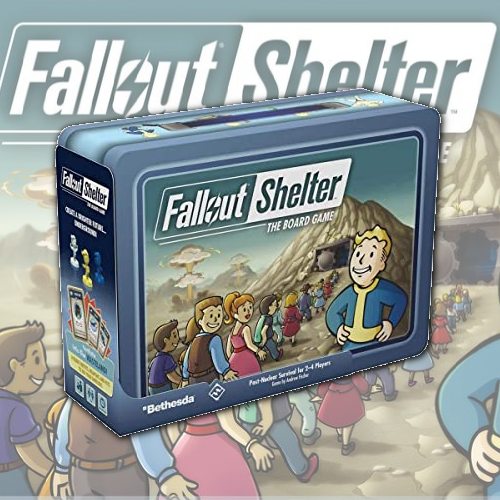
It doesn’t take much to get me excited about a game related to the Fallout franchise. I’ve played through several Fallout games both on the PC and PlayStation platforms, and have built up numerous shelters in the mobile version of Fallout Shelter. While the main series of games give huge open world regions to explore, Fallout Shelter did quite the opposite, keeping you underground and building up your own vault to ensure your dwellers are happy, they have enough water, food and electricity to get by and can head out on the occasional mission to gain resources, weapons and other paraphernalia. But when you’ve given people hundreds of hours of wasteland exploring, then hours upon hours or vault management on a smaller screen, where do you go next for more variety?
Step forward Fantasy Flight Games, bringing Fallout Shelter to the tabletop, complete with brilliant metal game-style lunchbox to keep all the bits in. It’s a simple enough game to play; the overseer has died and the players are competing to take up the role by building the best floor of the vault. Initially you set the game up with the standard top floor of the vault which contains the wasteland, entrance, diner, water treatment and power generator, as well as a lift shaft with enough spaces for each player to have their own floor. Placing your little Vault Boy characters (which are brilliant, by the way) on a room will allow you to collect resources, letting you stock up on water, power and food. Some areas need you to spend your resources to gain another, so you can spend some water by going out into the wasteland, but you’ll return with a weapon or other item from the selection of three cards available in the market area. So far, so simple.
But then you need to think about building up your own floor of the vault. Similar to the items, a market area offers three rooms, with each claimed room being replaced in the market area with another off the deck. As the main objective here is to make your dwellers as happy as possible, it’s important to make sue you get a good balance of rooms that will allow you to keep your occupants nice and chirpy while they go about their day to day life. Building a room opens up more opportunities for sending your dwellers to a range of different spaces, and if you train a dweller in one of your SPECIAL skills (therefore improving its skill, luck, intelligence or whatever else for a turn) you can increase the rewards that each room gives. But another way to get rewards, albeit through a slightly more tricky method, is for things to start going wrong.
On each turn you roll the dice to determine if any parts of the vault get affected by some kind of problem. That might be Radroaches, Deathclaws, a fire or some other kind of disaster. This brings out the most brilliant part of this game, whereby the cards for these disasters are partly transparent, sitting on top of the room itself and making it look like the problem has suddenly appeared in the room, while covering up the room’s label with the title of the problem and the rewards for sorting it. It’s a great way to do the cards, and reminded me of Mystic Vale that we reviewed a few years ago, letting you stack cards while still being able to access the information from below. It sounds odd that a Deathclaw could make your dwellers happy, but if you’re able to defeat it then the rewards are there for the taking. If you decide to ignore it then that area is unavailable, potentially starving you of resources that you need, especially if other players have already sent their dwellers to another space previously in that turn.
Once someone completes their floor of the vault with six rooms, or when the threat cards have all been used, the current round plays out and then the game ends. At this point, happiness points are added up and the player with the happiest crew of people wins. That’s not to say the person with the most rooms will win, and starting the final round doesn’t mean you have an advantage, so a race to the end isn’t necessarily the route to the win. As with other worker placement games it’s your choices along the way that can make the difference, as well as a dose of luck depending on which cards pop up and what you roll on the dice when determining the threats that’ll appear in each round.
One thing I thought was a shame was the lack of a single player way of playing. Aside from Fallout 76, the entire point of Fallout is the idea of being alone, working by yourself in a scary and punishing world, and while you’re still doing your own thing and competing against others it would’ve been nice to be able to dive in and have a way of playing by yourself. Still, if you want a single player Fallout board game then the actual Fallout game is still brilliant, so perhaps that’s not really an issue to dwell on much, but it’s worth being aware of if you’re used to the mobile game and might assume that this will work in the same way.
So for Fallout fans, or those of you who like worker placement style games, this is a very good bet for a few games as part of an evening of gaming. The components are great, the way the threats work is brilliant, and it’s dripping with the great Fallout theme we’ve come to know. Definitely worth a look.
This game was provided by Asmodee UK for an unbiased review.

Leave a Reply